
The Viperinae, or viperines, are a subfamily of venomous vipers endemic to Europe, Asia and Africa. They are distinguished by their lack of the heat-sensing pit organs that characterize their sister group, the subfamily Crotalinae. Currently, 13 genera are recognized. Most are tropical and subtropical, although one species, Vipera berus, even occurs within the Arctic Circle.

Trapelus is a genus of Middle Eastern agamid lizards, which contains 13 species.

Rostanga is a genus of sea slugs in the family Discodorididae. Some sources, such as The Sea Slug Forum still classify Rostanga in the family Dorididae.

Aplysiidae is the only family in the superfamily Aplysioidea, within the clade Anaspidea. These animals are commonly called sea hares because, unlike most sea slugs, they are often quite large, and when they are underwater, their rounded body shape and the long rhinophores on their heads mean that their overall shape resembles that of a sitting rabbit or hare. Sea hares are however sea snails with shells reduced to a small plate hidden between the parapodia, and some species are extremely large. The Californian black sea hare, Aplysia vaccaria is arguably the largest living gastropod species, and is certainly the largest living heterobranch gastropod.
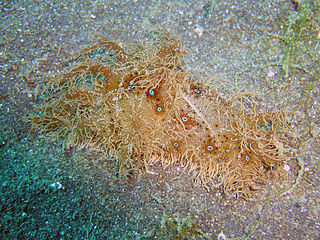
Bursatella leachii, common name the ragged sea hare or shaggy sea hare, is a species of large sea slug or sea hare, a marine gastropod mollusk in the family Aplysiidae, the sea hares. Previously thought to be a single worldwide species it is now known to be a species complex.
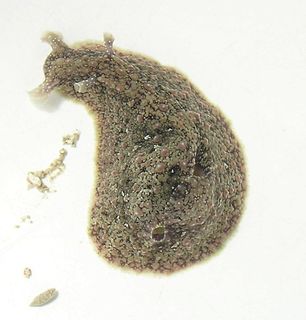
Dolabrifera is a genus of sea hares, a taxonomic group of sea slugs or marine opisthobranch gastropod mollusks belonging to the family Aplysiidae.

Notarchus is a genus of sea slugs or sea hares, marine opisthobranch gastropod mollusks in the family Aplysiidae, the sea hares.

Aplysia is a genus of medium-sized to extremely large sea slugs, specifically sea hares, which are one clade of large sea slugs, marine gastropod mollusks.
Uropeltis is a genus of nonvenomous shield tail snakes endemic to peninsular India. As of 2017, 23 species are recognized.

Parmacella is a genus of air-breathing land slugs, terrestrial gastropod mollusks in the family Parmacellidae.

Dolabrifera dolabrifera is a species of sea hare, a marine gastropod mollusc in the family Aplysiidae, the sea hares.

Veronicella sloanii, commonly called the pancake slug, is a species of air-breathing land slug, a terrestrial, pulmonate gastropod mollusk in the family Veronicellidae, the leatherleaf slugs.
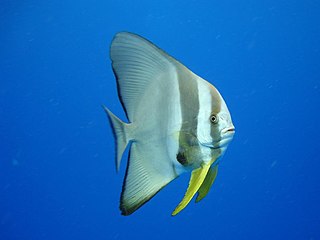
Platax is a genus of Indo-Pacific, reef-associated fish belonging to the family Ephippidae. There are currently five known extant species generally accepted to belong to the genus. They are one of the fish taxa commonly known as "batfish".
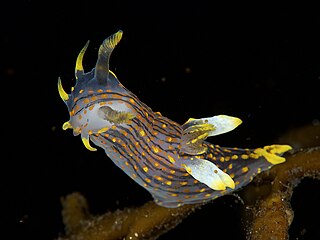
Polycera is a genus of sea slugs, specifically nudibranchs, shell-less marine gastropod molluscs in the family Polyceridae.

Pleurobranchus is a genus of sea slugs, specifically side-gill slugs, marine gastropod mollusc in the family Pleurobranchidae.

Onchidella celtica is a species of air-breathing sea slug, a shell-less marine pulmonate gastropod mollusk in the family Onchidiidae.
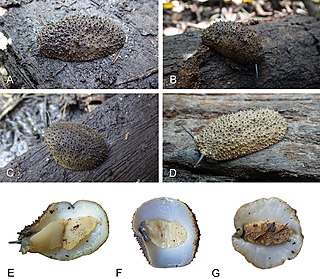
Onchidium is a genus of air-breathing sea slugs, shell-less marine pulmonate gastropod mollusks in the family Onchidiidae. There are only three species currently recognised in the genus.

Aeolidia is a genus of sea slugs, aeolid nudibranchs, marine gastropod mollusks in the family Aeolidiidae.

Le Règne Animal is the most famous work of the French naturalist Georges Cuvier. It sets out to describe the natural structure of the whole of the animal kingdom based on comparative anatomy, and its natural history. Cuvier divided the animals into four embranchements, namely vertebrates, molluscs, articulated animals, and zoophytes.
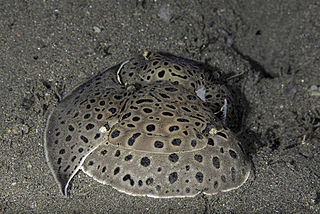
The Pleurobranchaeidae are a taxonomic family of sea slugs, marine gastropod molluscs in the clade Pleurobranchomorpha.


















